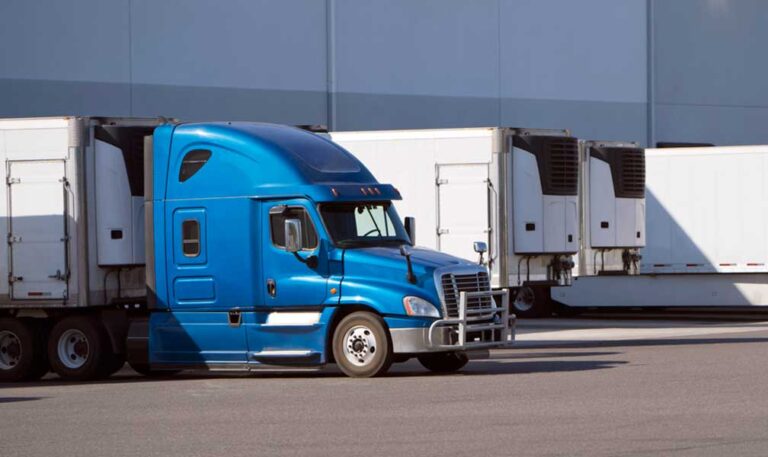Choosing which segment of trucking to work in is often a matter of personal preference. Pulling refrigerated trailers can be a rewarding experience and it can be profitable, but it comes with its own requirements for special handling.
Refrigerated trucking offers the opportunity to haul a variety of temperature-controlled products, from frozen items to fresh produce and even to items that must be protected against freezing in winter temperatures. Additionally, when temperature-controlled freight is scarce, the refrigeration unit can be turned off and the trailer used like any dry van trailer.
Running a refrigerated trailer, however, means more responsibility for the driver, who has to ensure that the temperature is set and the internal temperature of the trailer, including the freight, is within the limits set by the customer. If the product temperature is off, even by a few degrees, the receiver may reject the load or file a claim for damage.
It is important to understand the customer’s demands before loading the product. Shippers often place devices in the load that record the temperature periodically, so fluctuations in degrees can be cause for load rejection even if the temperature seems correct at the destination. Keeping the temperature as constant as possible is the goal, but the trailer and other factors can make it difficult.
Products such as ice cream, for example, may need to be kept at a temperature lower than zero to make sure the product doesn’t soften in transit. On a hot day, with the sun beating down on the trailer, the refrigeration unit may labor to keep the temperature down.
Fresh produce, on the other hand, has unique properties. It can’t be allowed to freeze or damage will occur. If it gets too warm, however, it can continue to ripen, producing methane gas that causes other produce to ripen. At warmer temperatures, bacteria can begin the process of rotting the product.
The temperature at which the product is loaded can cause problems, too. The refrigeration unit on the trailer is good at maintaining the temperature as the product is received, but not always good for changing the product temperature. For example, 40,000 pounds of vegetables loaded right at the field where they were harvested will be at the outdoor temperature of that location. Insisting that they be at 34 degrees when delivered may be more than the system is capable of. Good communication with the carrier or broker who assigned the load is important to make sure everyone is in agreement.
The Bill of Lading (BOL) is the document that records the customer requirements for temperature. It’s important to make sure the customer who is paying for the freight, if different from the shipper, is making the same demands as the shipper. If the load you accepted specifies one temperature while the paperwork specifies another, that’s an issue to resolve prior to loading.
The BOL is also where you note any discrepancies you find. If, for example, produce looks wilted or beyond freshness, note it on the BOL. If the temperature of the product isn’t accurate when you receive it, note that as well. Anything that doesn’t look right should be discussed with whomever assigned the load.
Receivers generally want products with a long shelf life, so products that are approaching their “use by” date or produce that doesn’t appear fresh could turn into a freight claim at the other end. Again, the time to call is before loading if possible and always before leaving the shipper.
Refrigerated trailers are often pre-loaded and ready to hook up to upon the driver’s arrival. It’s important to note on the BOL if this occurs, especially if the doors are closed and sealed. One problem is weight distribution. Since the refrigeration unit on the front of the trailer adds weight, loading heavy products in the front of the trailer can cause the tractor-trailer to be overweight on the drive axles. Improper loading can also result in freight shifting in the trailer, changing weight distribution and possibly damage.
Most refrigerated units have a lighted panel that can be observed in the driver’s side mirror, and some even connect to communication units in the cab. Regardless of the interface type, the driver is responsible for checking the temperature periodically to make sure it stays withing the parameters specified.
One choice the driver may have is whether to run the unit continuously or in a start/stop mode. Some shippers will specify continuous run because of the product, or you may have an option. Products that are frozen are usually handled on continuous, but produce and other medium temperature products may allow start/stop operation, which saves fuel. The unit starting and stopping can also make it difficult to sleep.
Some customers will require pre-cooling of the trailer, which is mostly defeated as soon as the doors are opened. Running the unit with the doors open isn’t a good idea, because the chute along the ceiling of the trailer directs the airflow right out the open doors while warmer air move in to take its place.
Most refrigeration units have a “defrost” function. On humid days, condensation can form on the evaporator and freeze, preventing air flow. The defrost function clears this without impacting the temperature of the load.
Although battery electric refrigeration units are being introduced, they have not yet occupied a significant share of the market. Your unit will run on diesel fuel, but the diesel used to run it is taxed differently because it isn’t for highway (driving) use. When fueling the tank on the trailer, be sure to specify “off highway” or “reefer” fuel so you’ll get the correct price.
Depending on the customer, refrigerated drivers can experience long waiting times and are sometimes tasked with handling some of the freight in their loads. Most drivers quickly learn which receivers to avoid.
Refrigerated trucking isn’t for every driver, but can provide an enjoyable career for those drivers who like the extra responsibilities that come with it.
Cliff Abbott is an experienced commercial vehicle driver and owner-operator who still holds a CDL in his home state of Alabama. In nearly 40 years in trucking, he’s been an instructor and trainer and has managed safety and recruiting operations for several carriers. Having never lost his love of the road, Cliff has written a book and hundreds of songs and has been writing for The Trucker for more than a decade.













